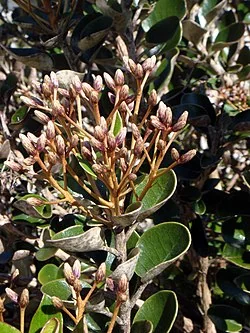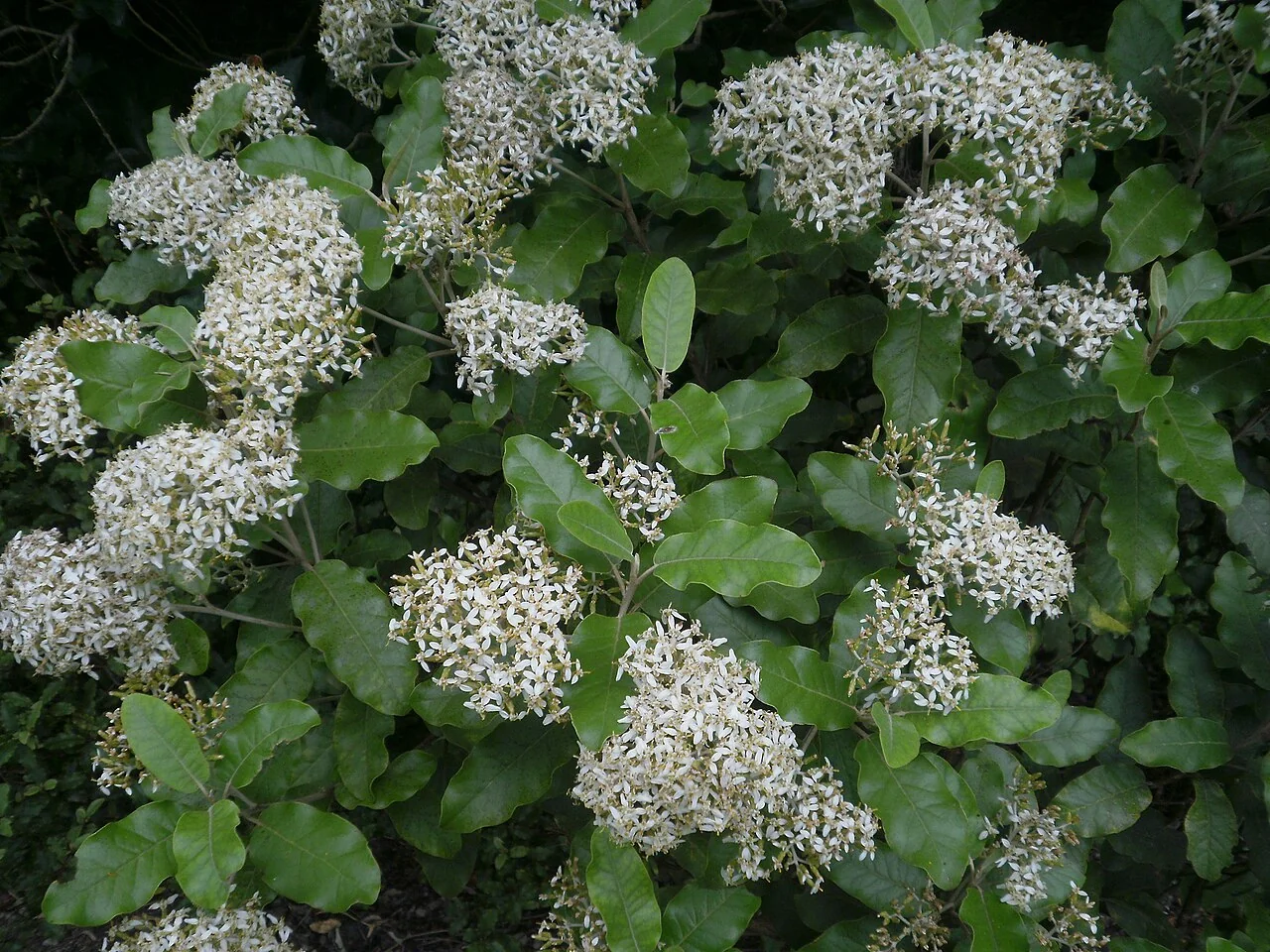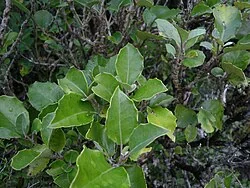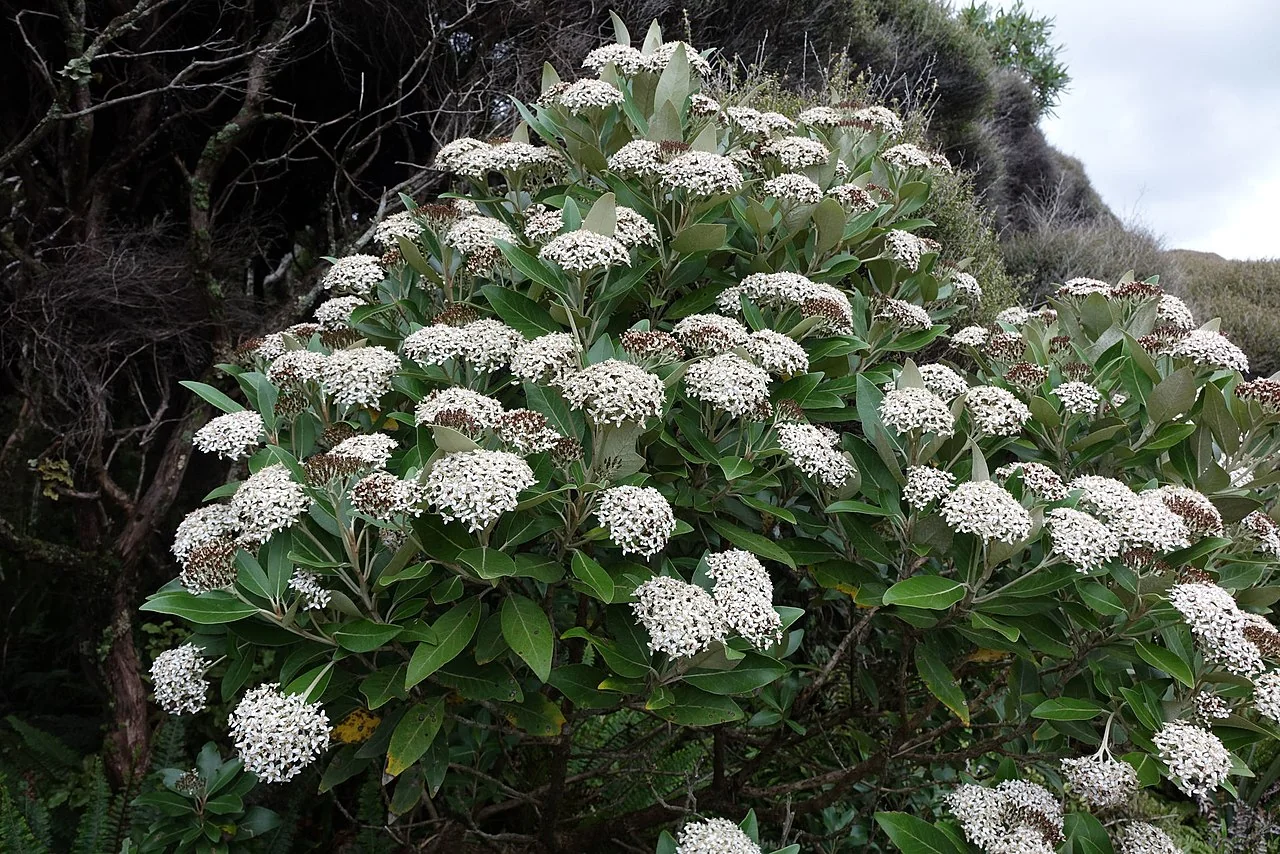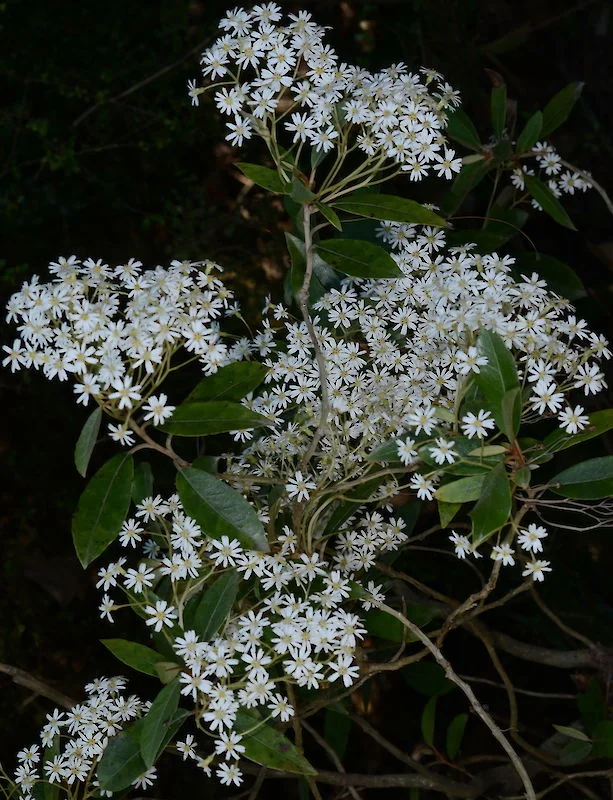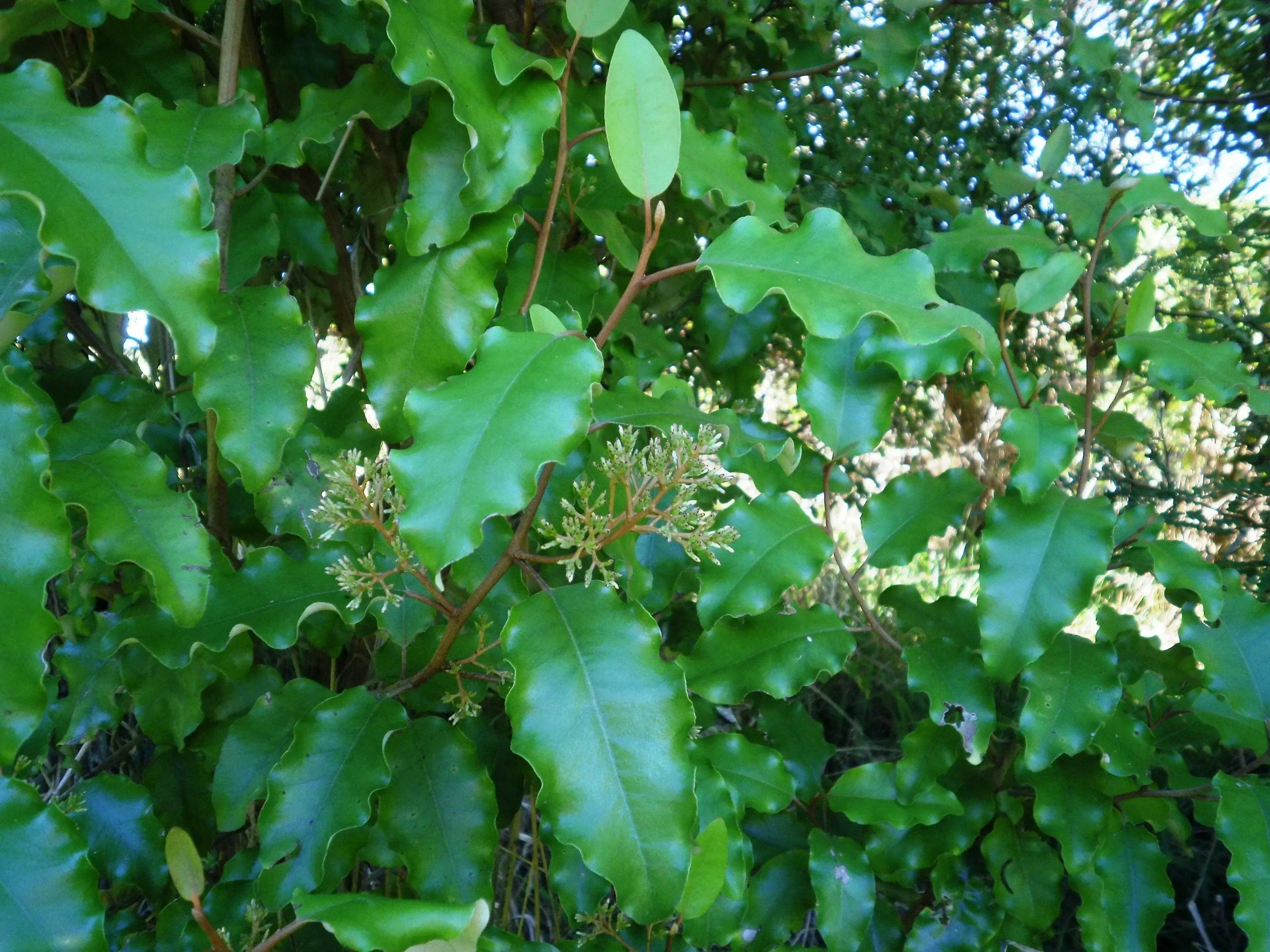
Lancewood Tree Daisy
Olearia lacunosa
Thick-leaved Tree Daisy (scientific name: Olearia lacunosa ) Thick-leaved Tree Daisy is a native tree daisy that produces masses of small white or cream flowers. Like other Olearia species, it's valued for its hardy nature and ability to provide shelter and nectar for native wildlife. Explore more in the native plants index .

Plant Description
Botanical Features
Local Names and Stewardship
The narrow-leaved Olearia lacunosa is a characteristic shrub of cool valleys and forest edges. Although specific customary uses are not well recorded, tree daisies feature in whakataukī and local plant lore as hardy shelter species. Today, hap ōī and council teams plant lacunosa on slips and track margins to stabilise soil and re-create layered shrubland canopies; this living shelter improves mahinga kai habitat and protects taonga species from desiccating winds.
Lancewood Tree Daisy ( Olearia lacunosa ) is a distinctive shrub or small tree native to New Zealand, typically growing as a robust, spreading shrub, reaching heights of 1.5 to 5 meters. It features long, narrow, leathery leaves that are dark green on the upper surface and have a soft, rusty-fuzzy white or brown underside. The leaves are often wrinkled, with curled-under or down-turned margins, and the veins are conspicuously sunken above and very prominent beneath, creating a series of roughly rectangular hollows on the lower surface. They range from 7.5 to 17 cm long and 1 to 2.5 cm wide. The rough, grey bark flakes in long, thin strips, similar to that of the tōtara tree. During spring and summer, it produces clusters of white daisy flowers with yellow centers. Each flower head is typically 3/16 to 3/8 inches wide and contains eight to twelve florets.
Quick Facts
Overview
| Scientific Name | Olearia Lacunosa |
|---|---|
| Height | 2-6 m |
| Spread | 2-4 m |
| Water Needs | Low to moderate |
| Light | Full sun to partial shade |
| Frost Tolerance | Moderate to good |
| Salt Tolerance | Moderate |
| Growth Rate | Moderate |
| Lifespan | Long-lived |
Climate Best Suited to
Regional climate suitability across major New Zealand cities.
Regional Suitability
| Whangārei | Ideal |
| Auckland | Ideal |
| Hamilton | Suitable |
| Rotorua | Suitable |
| Tauranga | Ideal |
| Gisborne | Ideal |
| New Plymouth | Ideal |
| Whanganui | Ideal |
| Palmerston North | Suitable |
| Napier | Ideal |
| Wellington | Ideal |
| Nelson | Ideal |
| Christchurch | Suitable |
| Dunedin | Suitable |
| Invercargill | Suitable |
| City | Climate Suitability |
|---|
Natural Habitat
Lancewood Tree Daisy is native to the North and South Islands of New Zealand, where it can be found at altitudes up to 1,500 meters. This evergreen shrub thrives in environments characterized by sporadic rainfall, preferring well-draining soil that is allowed to dry out between waterings. It requires full sun exposure and grows best in garden loam with a soil pH between 6 and 7. While it can tolerate mild winters in sheltered locations, it is not considered genuinely hardy in colder climates and flourishes in milder regions.
Conservation
Plant Conservation
Olearia lacunosa , also known as the lancewood tree daisy, is an endemic vascular plant native to New Zealand. According to the New Zealand Threat Classification Series from both 2012 and 2017, its conservation status is "Not Threatened".
Growing Requirements
Soil Requirements
Prefers moist, free-draining, humus-rich soils typical of high rainfall districts; avoid stagnant water.
Light Requirements
Light shade to full sun in sheltered sites; tolerates cool, wet climates.
Water Requirements
Moderate-high moisture; maintain even watering in summer.
Planting Guide
Growing Conditions:
- Sunlight: Olearia lacunosa thrives in full sun and can tolerate hot overhead sun.
- Soil: It prefers well-draining soils, ranging from mildly acidic to mildly alkaline. Enriched soil is beneficial.
- Moisture: The plant can tolerate periods of dryness between waterings but also adapts to consistently moist conditions.
- Hardiness Zones: It is hardy in zones 9-10.
- Tolerances: This species is notably tolerant of high winds, second-line salt wind, and light frost.
Ecological Role
Environmental Benefits
Olearia lacunosa forms part of cool, moist forest and scrub communities from lowland to montane zones. Its summer flower heads feed generalist native pollinators, while the dense evergreen crown offers cover and perching sites along tracks and forest margins exposed to wind and rainfall.
- Pollinator forage: Abundant daisy heads support flies, beetles and solitary bees.
- Habitat structure: Evergreen canopy provides edge shelter and microclimate buffering.
- Soil conservation: Root systems help retain moisture and reduce surface erosion.
Uses and Significance
Specialist Native Plantings
Olearia lacunosa is a handsome, narrow-leaved tree daisy specifically suited to Westland-type plantings that replicate the high rainfall, cool climate conditions of New Zealand's West Coast. This distinctive species with its rough grey bark and dark green foliage adds authentic character to montane and subalpine garden recreations. Its unique leaf structure with sunken hollows and curved edges provides interesting textural contrast in native plant collections.
Ecological and Ornamental Value
The white daisy flowers with yellow centres provide essential pollinator support in cool, moist environments where flowering plants may be limited. This evergreen shrub or small tree contributes to New Zealand's montane biodiversity while offering year-round structure in gardens. However, it can be temperamental outside its natural habitat, making it best suited to specialist collections that can provide appropriate cool, moist conditions.
Cultural Importance
Botanical Context
Known as the lancewood tree daisy, Olearia lacunosa links modern gardens to the early exploration of New Zealand's mountain daisies. Growing it in collections and revegetation projects helps showcase the country's distinctive small-leaved daisy trees.
Cultural Significance
While Olearia lacunosa , commonly known as the Lancewood Tree Daisy, is a native New Zealand plant known to Māori for centuries, specific detailed cultural significance or traditional uses directly attributed to this particular species are not extensively documented. However, the broader Olearia genus, to which Olearia lacunosa belongs, held practical value for Māori. Larger Olearia species, such as "akeake," were utilized for their strong, dense wood in crafting tool handles, weapons, and construction materials. Some Olearia species also provided traditional medicines, with specific applications varying among different iwi (tribes) and regions. It is important to distinguish Olearia lacunosa from the "Lancewood" or "horoeka," which primarily refers to species within the Pseudopanax genus, particularly Pseudopanax crassifolius . These Pseudopanax species have more documented Māori cultural significance. While Olearia lacunosa is recognized for its distinctive textural qualities and hardiness in New Zealand's high country, its specific role in Māori cultural practices or folklore is not as clearly defined as that of the Pseudopanax lancewoods.
Landscaping Ideas
Lancewood Tree Daisy ( Olearia lacunosa ) is a distinctive native shrub that brings authentic alpine character and unique textural interest to New Zealand landscaping projects. Its striking lancewood-style foliage, rough exfoliating bark, and robust subalpine constitution make it particularly valuable for creating mountain-themed gardens and challenging site solutions where many other plants struggle to establish.
Alpine and Mountain Garden Applications
- Authentic alpine landscapes: Essential component for recreating authentic New Zealand subalpine and alpine environments, naturally suited to elevations from 900-2300 m where it creates realistic mountain flora displays.
- Rock garden features: Excellent for large rock gardens and alpine collections where its distinctive narrow foliage and rough bark provide authentic mountain character and structural interest.
- High-elevation gardens: Perfect for mountain properties and hill country landscapes where extreme weather conditions require exceptionally hardy plant selections that can withstand frost, wind, and temperature variations.
- Subalpine restoration: Valuable for ecological restoration projects in subalpine zones, helping to recreate natural plant communities and provide habitat for native species adapted to high-elevation environments.
Specialized Foliage and Texture Gardens
- Architectural specimens: Individual plants create striking focal points with unique lancewood-style foliage featuring distinctive sunken veins and contrasting white-felted undersides that provide year-round visual interest.
- Textural contrast plantings: Narrow, leathery leaves offer excellent contrast when paired with broad-leaved or fine-textured companions, creating sophisticated layered planting designs with varied leaf forms.
- Bark feature gardens: Rough, grey bark that exfoliates in large strips provides exceptional winter interest and structural appeal, particularly effective in gardens emphasizing natural bark textures.
- Evergreen backbone: Provides consistent year-round structure in mixed plantings, maintaining strong architectural presence during winter months when deciduous plants are dormant.
Challenging Site Solutions
- Coastal adaptability: One of the best choices for seaside gardens where salt tolerance and wind resistance are essential, providing reliable performance in challenging maritime environments.
- Exposed position plantings: Outstanding tolerance for wind and exposure makes it valuable for windswept sites, ridgelines, and areas where shelter from prevailing winds is not available.
- Poor soil tolerance: Thrives in free-draining soils of varying quality, making it suitable for rocky, gravelly, or nutrient-poor sites where many other plants fail to establish.
- Slope stabilization: Root systems help stabilize banks and slopes while providing erosion control, particularly valuable on steep sites prone to soil movement or water erosion.
Specialist Garden Collections
- Native plant collections: Prized addition to specialist New Zealand native gardens and botanical collections, representing unique subalpine flora rarely seen in cultivation.
- Conservation gardens: Important for conservation-focused landscapes that preserve and display New Zealand's endemic mountain flora, contributing to biodiversity preservation efforts.
- Educational demonstrations: Excellent for botanic gardens, arboreta, and educational facilities where its distinctive characteristics can illustrate subalpine plant adaptations and endemic biodiversity.
- Rare plant enthusiast gardens: Highly valued by collectors of unusual native plants, offering unique characteristics and challenging cultivation that appeals to specialist gardeners.
Seasonal Interest and Wildlife Value
- Spring and summer flowering: Clusters of white daisy flowers provide seasonal highlights and attract native pollinators, supporting local biodiversity and ecosystem function.
- Wildlife habitat creation: Dense branching provides shelter and nesting opportunities for small birds and beneficial insects, contributing to habitat diversity in garden environments.
- Year-round appeal: Evergreen nature ensures consistent landscape value through all seasons, with changing light conditions highlighting the contrast between dark upper leaf surfaces and pale undersides.
- Pollinator support: Spring and summer blooming period provides valuable nectar resources for native bees and other pollinators during peak activity periods.
Cultivation Considerations for Landscape Success
- Slow establishment: Can be slow to establish initially, requiring patience and consistent care during the first few growing seasons before reaching mature size and form.
- Drainage requirements: Essential to provide excellent drainage, as overwatering and waterlogged conditions are the primary threats to healthy growth and long-term survival.
- Light positioning: Performs best in full sun to partial shade locations where adequate light supports healthy growth and maintains compact, attractive form.
- Moderate growth management: Moderate growth rate makes it easy to maintain without regular pruning, naturally developing attractive shape that never becomes overwhelming or unmanageable.
Design Integration and Companion Planting
- Subalpine plant communities: Pairs excellently with other mountain natives like Hebe, Dracophyllum, and Celmisia species for authentic high-elevation ecosystem recreation.
- Contrast plantings: Distinctive narrow foliage creates striking contrast with rounded or broad-leaved companions, enhancing overall garden composition and visual interest.
- Seasonal plant combinations: Provides evergreen structure for gardens featuring alpine bulbs, seasonal perennials, or deciduous mountain species that require permanent backdrop plantings.
- Natural garden themes: Essential component of wild or naturalistic garden designs that emphasize New Zealand's unique mountain landscapes and endemic plant communities.
Seasonal Care Calendar
Spring
Mulch and feed with compost.
Summer
Maintain moisture; shelter from hot, dry winds.
Autumn
Light shaping; renew mulch.
Winter
Minimal care; ensure drainage.
Pruning and Maintenance
Techniques and Timing
Lancewood tree daisy requires careful, light pruning to maintain its natural form and health, particularly given its temperamental nature in cultivation. Shape pruning should be minimal and focused on maintaining the plant's characteristic narrow-leaved appearance. Avoid hard renovation cuts as this West Coast native may struggle to recover from severe pruning. The distinctive rough grey bark that hangs in strips should be left undisturbed, as this is a key identifying feature of the species.
How to Grow Lancewood Tree Daisy
Lancewood Tree Daisy is a handsome, narrow-leaved tree daisy specifically suited to Westland-type plantings that replicate the high rainfall, cool climate conditions of New Zealand's West Coast. This distinctive species with its rough grey bark and dark green foliage adds authentic character to montane and subalpine garden recreations. Its unique leaf structure with sunken hollows and curved edges provides interesting textural contrast in native plant collections. Understanding its propagation methods is key to successfully growing this unique species.
From Cuttings
Semi-hardwood cuttings can be challenging with this temperamental species, requiring careful attention to timing and conditions. Take cuttings from healthy, non-flowering shoots and treat with rooting hormone. Maintain high humidity and cool, moist conditions that replicate the plant's natural West Coast environment. Success rates may be variable due to the species' specific habitat requirements. This method is best suited for experienced propagators or in specialized nurseries.
From Seed
Propagating Lancewood Tree Daisy from seed is a viable method, though it requires fresh seeds and careful attention to conditions. The fluffy seeds should be surface-sown on a well-draining but moisture-retentive mix that mimics the humus-rich soils of its native montane forests. Keep evenly moist and provide cool conditions with protection from temperature extremes. Fresh seed typically offers better germination rates, though establishing seedlings to maturity can be challenging without appropriate cool, high-humidity conditions. This method is crucial for maintaining genetic diversity and for large-scale restoration projects.
Pests and Diseases
Lancewood Tree Daisy ( Olearia lacunosa ) is generally a hardy and resilient subalpine shrub that experiences relatively few serious pest or disease problems when grown in appropriate conditions. Its natural adaptation to challenging high-elevation environments contributes to its overall robust constitution and natural resistance to many common cultivation issues.
Primary Cultural Challenges
- Overwatering and root rot: The most significant threat to healthy growth is overwatering and waterlogged conditions. Root rot is the most likely cause of problems, as this species is particularly sensitive to wet soil and poor drainage.
- Establishment difficulties: Can be slow to establish and may struggle during initial cultivation phases, requiring patient care and optimal conditions to develop strong root systems and healthy growth patterns.
- Propagation challenges: Exceedingly difficult to raise from cuttings, with variable success rates requiring specialized techniques and controlled environments for successful propagation.
- Climate sensitivity: While hardy in appropriate conditions, may struggle in climates that are too hot, humid, or waterlogged, requiring careful site selection for successful cultivation.
Environmental Stress Factors
- Light deficiency: May have difficulty thriving and will drop leaves without ample sunlight. Insufficient light conditions lead to poor growth, loss of compact form, and reduced flowering.
- Drainage problems: Extremely sensitive to waterlogged conditions which quickly lead to root rot and plant decline. Essential to provide excellent drainage in all planting situations.
- Temperature extremes: While frost-tolerant, may struggle in areas with excessive heat or humidity, performing best in cooler climates that mimic its natural subalpine habitat.
- Soil compaction: Poor soil structure and compaction can impede root development and drainage, leading to stress and increased susceptibility to other problems.
Disease Resistance and Management
- General disease resistance: Like many Olearia species, demonstrates good natural resistance to most fungal and bacterial diseases when grown in appropriate conditions with good air circulation.
- Fungal disease prevention: Ensure excellent air circulation around plants and avoid overhead watering to prevent conditions favorable for fungal development.
- Root health maintenance: Focus on maintaining healthy root systems through proper drainage, appropriate watering, and avoiding soil disturbance around established plants.
- Stress reduction: Healthy plants naturally resist disease problems, so maintaining optimal growing conditions is the best preventive approach.
Pest Management
- General pest resistance: Natural mountain habitat adaptation provides resistance to many common garden pests, though some monitoring is still beneficial during growing seasons.
- Scale insects: May occasionally be affected by scale insects, particularly in sheltered garden situations. Monitor regularly and treat with horticultural oil if infestations develop.
- Aphids: Possible occasional aphid problems during spring growth periods. Use organic treatments like insecticidal soap if serious infestations occur.
- Browsing protection: Young plants may need protection from rabbits or other browsing animals until well-established and mature.
Cultivation Best Practices
- Proper watering technique: Allow soil to dry slightly between waterings and water at soil level rather than overhead. Deep, infrequent watering is preferred over frequent shallow watering.
- Drainage enhancement: In heavy soils, plant on raised beds or mounds to improve drainage. Add coarse sand or gravel to improve soil structure if necessary.
- Site selection: Choose locations with full sun to partial shade and excellent drainage. Avoid low-lying areas where water accumulates or where air circulation is poor.
- Minimal soil disturbance: Once established, avoid disturbing the root zone as this species can be sensitive to root damage and soil compaction.
Specialized Growing Considerations
- Container cultivation: Excellent drainage is even more critical in container situations. Use well-draining potting mix and ensure containers have adequate drainage holes.
- Winter protection: In borderline climate zones, provide protection from excessive winter wet rather than cold, as moisture-related problems are more likely than freeze damage.
- Gradual acclimatization: Young plants benefit from gradual exposure to full garden conditions rather than immediate transplanting to challenging sites.
- Long-term patience: This species rewards patient gardeners who understand its slow establishment and specific requirements rather than those expecting quick results.
Monitoring and Early Intervention
- Regular health checks: Monitor plants regularly for signs of stress, particularly during establishment phase and after periods of wet weather.
- Drainage assessment: Regularly check that drainage remains adequate, especially after heavy rains or changes to surrounding landscape that might affect water flow.
- Growth pattern observation: Healthy plants maintain compact growth and good foliage colour. Changes in growth pattern or leaf colour often indicate environmental stress.
- Preventive maintenance: Remove any dead or damaged growth promptly and maintain good air circulation around plants to prevent problems before they develop.
Success with Lancewood Tree Daisy depends primarily on understanding and providing its specific cultural requirements rather than managing pest and disease problems, as healthy plants in appropriate conditions rarely experience serious issues.
Bonus Tip
Expert Growing Advice
Lancewood tree daisy ( Olearia lacunosa ) shows best leaf texture in morning sun with afternoon shade at low elevation. In high-rainfall areas, plant on slight mounds to keep the flaking bark dry and decorative.

